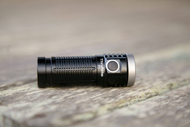Recent Posts
Thrunite T1 Flashlight Review - You need have this little monster!
Posted by zeroair on 6th Jul 2020

Thrunite has released something I’ve wanted for a long time now. This is a pocket friendly 18350 light, with an e-switch. It’s a good production version counterpoint to many of the “custom” triples out there, most of which have mechanical tail clickies.
Official Specs and Features
Here’s a link to the official product page.
Versions
Just one body is available, but that body can be had in CW or NW versions. What I have is the cool white.
Short Review
I like this little light a lot. I’m super happy that it takes 18350 cells (and even comes with one)! I think it could be made shorter, because the included (protected) cell is quite long. But overall, I’m very happy with this light, and I’m taking into consideration the price. At the price, it’s a great light.
What’s Included
- Thrunite T1 Flashlight
- Thrunite 1100mAh 18350 (protected, button top) (not pictured here)
- Charge cable (USB to micro-USB)
- Spare o-rings (2)
- Pocket clip
- Lanyard
- Spare charge port cover
- Manual and papers
Package and Manual
Standard Thrunite package. The end of the box includes CW/NW checkboxes.

The manual is brief, and in 4 languages (only English shown here).
Build Quality and Disassembly
This tiny light has a quality bit of heft to it. The anodizing is great. I can’t measure the thickness of it but it feels as high quality as almost any light like this. The alternate take on knurling is a nice feature, and doesn’t sacrifice grip.
The outside of the tailcap is not exciting. The inside of the tailcap/cell tube has a big coated spring, and a magnet, too.
The head, on the other hand, has a brass button. The button isn’t shrouded, nor is it springy, but the light does work just fine with any 18350 (including those that are actually sized according their name – 35mm long cells).
There’s a lot going on with this mcpcb! Sort of neat to see all this stuff exposed.
The threads are anodized and square cut, and the body tube has a 2mm unanodized, unthreaded section. As far as I can tell, electrical contact is made only on the rim and not on the sides, so I’m not sure what the point of this section is. It’s not an inner sleeve, either.
Size and Comps
Weight: 71.5g with battery
Dimensions: 69.5mm*26.5mm*22mm. I confirm these measurements.
No doubt there could be shorter 18350 lights, but this is quite short indeed. And I think could go even shorter, but that’d require a non-Thrunite cell, and no protection.
Retention and Carry
First let’s mention the magnet in the tailcap again. The magnet is quite strong and holds the light easily. I think it’d be possible to pull the spring and take the magnet out, but I did not try.
Next is the pocket clip. It’s a friction fit clip, and lives only on the tail end of the light. It’s a double direction clip, though the mouth doesn’t allow too great access for bezel up carry. In fact the shoulder doesn’t offer great ease of access either – I had to fiddle with the clip (ie two handed operation) every time I put the light on my pocket. Not a huge deal, but just another reason I don’t care for these type clips.
There’s also a lanyard, which should be connected through the hole in the tailcap.
Power and Runtime
Thrunite includes the cell intended for powering the T1. It’s an 18350 cell, with Thrunite added protection, and a button top. Those two things make it quite long to be sure, but of course it fits in this light easily. I measure the cell at 39.7mm long.
As you can see, the Thrunite 18350 is much longer than an unprotected flat top 18350.
The Thrunite cell protrudes around 3mm out of the light, while the unprotected 18350 is around 1mm below the lip.
Both of those cells work just fine in this light.
Two runtimes follow. Turbo holds out for a couple of minutes around 1500 lumens (as claimed) with reasonable strength, then steps down heavily to around 700 lumens (“High”) (as claimed, but the claim is actually “408 lumens” on stepdown). Once the cell voltage drops off, so does the light, and then shuts off with the cell around 2.8V. The indicating switch starts warning at around 3.2V with a blue indication, then turns red at 2.9V. (It’ll also flash red, but that’s at ~2.8V, and fairly dim.)


































